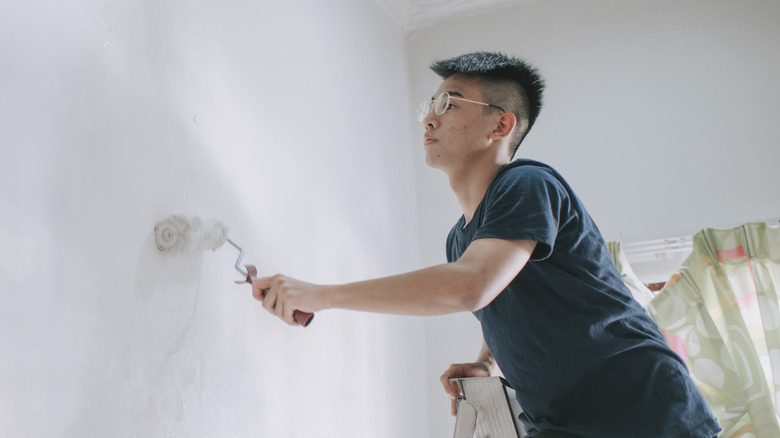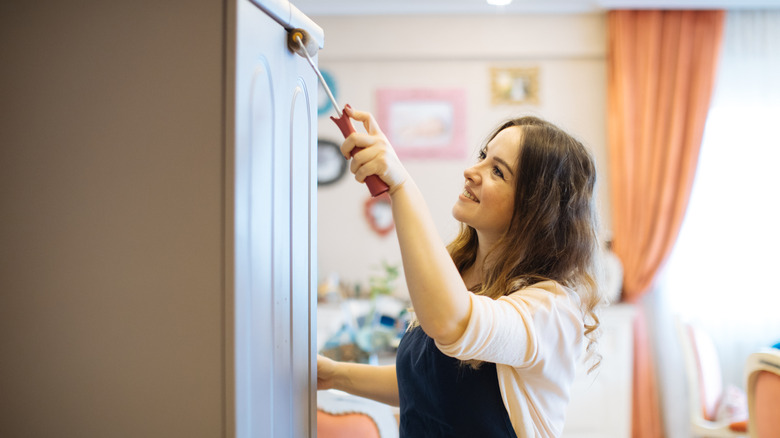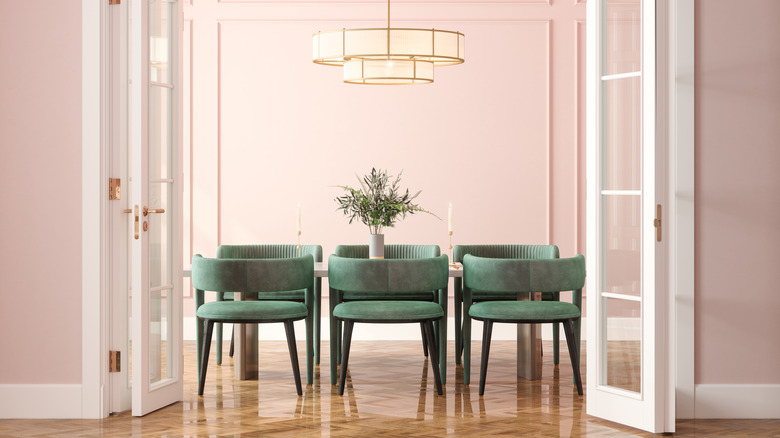What Is 'Dead Flat' Paint And Where Would You Want To Use It
Painting can often feel a lot like entering an alien world. You march into your local home improvement store, fortified with visions of home-transforming grandeur, only to encounter rows of paint cans boasting enigmatic labels like "eggshell," "satin," "semi-gloss," and the most cipher-like of them all — "dead flat" paint. Far from being the corpse its name might suggest, dead flat paint is the unsung hero of the paint finishes family. Essentially, it's a water-based ultra-matte option characterized by minimal to no gleam and fewer light-reflective properties.
Picture yourself staring at a wall that's seen better days — years of minor dings, rough patches, and even Uncle Jimmy's misguided attempt to open a bottle of pop against it during the family BBQ of 2016. Sounds like a lost cause until our unassuming hero — dead flat paint — strides in. A darling of discerning decorators and wall imperfections' worst enemy, this hero is composed of a traditional alkyd resin and delivers a finish so flat that it might instigate a tinge of self-consciousness in a pancake (pun purely intended).
But again, where do you use dead paint? Ultra-matte finish is quite the crowd-pleaser when it comes to giving your space a classic, time-worn, and yet, tastefully elegant appeal. Plus, touch-ups are seamless since its low sheen won't spotlight repairs the way glossier finishes will. It's the preferred choice for adult bedrooms, stairwell ceilings, dining rooms, and other low-traffic areas in your home.
Dead flat paint: The subtle hero against blemishes
If the captivating world of paint finishes were a circus, glossy and satin would definitely be the ringleader hogging the brightest spotlight. However, don't overlook dead flat paint, likened to the tightrope walker balancing on a thin line above an awed crowd — less flashy, sure, but with an allure all its own. Part of the dead flat paint's charm lies in its ability to prevail against stippling, an uneven or textured effect caused by paint blotches. Thanks to its almost non-existent sheen level (2%), this quietly competent contestant is a fantastic choice for cosmetically concealing unintentional surface irregularities. If you're toeing the line of furniture restorations, dead flat paint like the Behr Pro i300 at The Home Depot is your time machine, imparting charm to your pieces without hurting your wallet.
While the remarkable qualities of ultra-matte paint earn it high grades, it's a subject that requires serious practice before you can ace its application. It isn't your everyday DIY subject but requires a specific layoff method for the optimal result. Think of it as that tricky piece of IKEA furniture you always needed help assembling — a professional touch can make all the difference. And much like a sensitive, soulful poet, it may suffer under the rigors of high foot traffic or enthusiastic pet encounters. But, with its water-based composition, quick-drying nature, and low VOC content, it remains a beautifully compelling — albeit understated — protagonist in your home décor story.
How and where do you use dead flat paint?
Fancy the dramatic effect of a single color cascading an entire room? Welcome to the world of color drenching and its affable companion: dead flat paint. This wondrous multi-surface colorist can help you create illusions of grandeur and more space. Its superpowers extend across walls, woodwork, and less common elements like metal furniture. And thanks to its light-absorbing nature, it's an ideal choice for masking surface imperfections. However, remember that ultra-matte paint finish is a sensitive soul, cherishing a quiet night over a loud party.
So, in which rooms should you use dead flat paint? Low-traffic areas top the charts. Think of that adult bedroom, a tranquil oasis after a day of intense adulting; the dining room where the only shine would come from your spotless cutlery; stairwell ceiling; and the study, a serene retreat where the biggest reflections should be of thoughts, not light. Keep this unassuming hero away from bustling areas like the kitchen, kid's room, and bathrooms.
Diving into the practicality pool, dead flat paint generously covers about 478 square feet per gallon. It's not picky about its accomplices either, welcoming applications from brush, roller, or spray gun. An all-rounded preparation routine involving effective dirt cleansing and priming precedes this spectacle. For easier application and a quality finish free of brush marks, incorporate an additive compatible with water-based paints. A pristine workspace is key to avoiding dust-induced texture.


